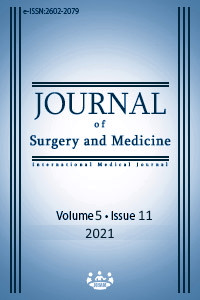The investigation of antifungal susceptibilities of Kluyveromyces marxianus and Clavispora lusitaniae strains isolated from various clinical specimens
Keywords:
Antifungal susceptibility, Clavisopra lusitaniae, Kluyveromyces marxianus, SequencingAbstract
Background/Aim: C. albicans remains the most common pathogen responsible for invasive candidiasis. On the other hand, increased rates of candidiasis have been reported worldwide, caused by other Candida species (such as K. marxianus and C. lusitaniae). Considering these uncommon yeasts may be crucial pathogens in the future, it is preferable to describe the in-vitro activities of antifungal agents as potential options for their treatments. This study aimed to evaluate the in-vitro activity of nine different antifungal agents that are routinely used to contribute to the treatment of the infections caused by K. marxianus and C. lusitaniae. Methods: The study included 21 K. marxianus and eight C.lusitaniae strains isolated from various clinical specimens of patients with suspected invasive fungal infection. Conventional identification was confirmed using the molecular methodology of DNA sequencing analysis. Antifungal susceptibilities of the isolates were tested using the Sensititer Yeast One Test Panel Y06 kit, a colorimetric microdilution test. Results: For K. marxianus, amphotericin B had the highest geometric mean MIC (1 μg/mL) and voriconazole had the lowest geometric mean MIC (0.010 μg/mL). For C. lusitaniae, flucytosine had the highest geometric mean MIC (8 μg/mL) and voriconazole had the lowest geometric mean MIC (0.011 μg/mL). Conclusion: Considering that these two species, rare causes of invasive candidiasis nowadays, may become important pathogens in the future, it is reasonable to investigate the in-vitro activities of antifungal agents that can be used in their treatment.
Downloads
References
Saleh Q, Kovàcs R, Kardos G, Gesztelyi R, Kardos T, Bozo A, et al. Decreased killing activity of micafungin against Candida guilliermondii, Candida lusitaniae and Candida kefyr in the presence of human serum. Microb Drug Resist. 2017;23:764-70. doi: 10.1089/mdr.2016.0241.
Gomez-Lopez A, Pan D, Cuesta I, Alastruey-Izquierdo A, Rodriguez-Tudela JL, Cuenca-Estrella M. Molecular identification and susceptibility profile in vitro of the emerging pathogen Candida kefyr. Diagn Microbiol Infect Dis. 2010;66:116-9. doi: 10.1016/j.diagmicrobio.2009.06.007.
Brandt ME, Lockhart SR. Recent taxonomic developments with Candida and other opportunistic yeasts. Curr Fungal Infect Rep. 2012;6:170-7. doi: 10.1007/s12281-012-0094-x.
Corpus K, Hegeman-Dingle R, Baijoka I. Candida kefyr, an uncommon but emerging fungal pathogen:report of two cases. Pharmacotherapy. 2004;24:1084-8. doi: 10.1592/phco.24.11.1084.36140.
Dufresne SF, Marr KA, Sydnor E,Staab JF, Karp JE, Lu K, et all. Epidemiology of Candida kefyr in patients with hematologic malignancies. J Clin Microbiol. 2014;52:1830-7. doi: 10.1128/JCM.00131-14.
Viudes A, Peman J, Canton E, Salavert M, Ubeda P, Lopez-Ribot JL, et al. Two cases of fungemia due to Candida lusitaniae and a literature review. Eur J Clin Microbiol. Infect Dis 2002;21:294-9. doi: 10.1007/s10096-002-0713-5.
McClenny NB, Fei H, Baron EJ, Gales AC, Houston A, Hollis RJ, et al. Change in colony morphology of Candida lusitaniae in association with development of amphotericin B resistance. Antimicrob Agents Chemother. 2002;46:1325-8. doi: 10.1128/aac.46.5.1325-1328.2002
Horn DL, Neofytos D, Anaissie EJ, Fishman JA, Steinbach WJ, Olyaei AJ, et al. Epidemiology and outcomes of candidemia in 2019 patients: data from the prospective antifungal therapy alliance registry. Clin Infect Dis. 2009;48:1695-703. doi: 10.1086/599039
Colak M, Asgin N. Retrospective assesment of fungal pathogens isolated from various clinical samples in a tertiary care hospital in Turkey: A cross-sectional study. J Surg Med. 2021;5:362-6.
Desnos-Ollivier M, Moquet O, Chouaki T, Guerin AM, Dromer F. Development of echinocandin resistance in Clavispora lusitaniae during caspofungin treatment. J Clin Microbiol. 2011;49: 2304-6. doi: 10.1128/JCM.00325-11
Zhang H, Ran Y, Li D, Liu Y, Xiang Y, Zhang R, Dai Y. Clavispora lusitaniae and Chaetomium atrobrunneum as rare agents of cutaneous infection. Mycopathologica. 2010;169: 373-80. doi: 10.1007/s11046-009-9266-9
Weichert S, Reinshagen K, Zahn K, Geginat G, Dietz A, Kilian AK, et al. Candidiasis caused by Candida keyfr in a neonate: case report. BMC Infect Dis. 2012;12:61. doi: 10.1186/1471-2334-12-61
Borg-von Zepelin M, Kunz L, Rüchel R, Reichard U, Weig M, Gross U: Epidemiology and antifungal susceptibilities of Candida spp. to six antifungal agents: results from a surveillance study on fungaemia in Germany from July 2004 to August 2005. J Antimicrob Chemother. 2007;60: 424-8 doi: 10.1093/jac/dkm145
Turk-Dagi H, Findik D, Senkles Ç, Arslan U. Identification and antifungal susceptibility of Candida species isolated from bloodstream infections in Konya, Turkey. Ann Clin Microbiol Antimicrob. 2016;15:36. doi: 10.1186/s12941-016-0153-1
Sendid B, Lacroix C, Bougnoux ME. Is Candida kefyr an emerging Pathojen in Patients with oncohematological diseases? Clin Infect Dis. 2006;43:666-7. doi: 10.1086/506573
Rahmati E, Correa AJ, She RC. A budding case infectious endocarditis: Candida lusitaniae. ID cases. 2019;19:e00679. doi: 10.1016/j.idcr.2019.e00679
Khan Z, Ahmad S, Al-Sweih N, Khan Seema, Joseph L. Candida lusitaniae in Kuwait: Prevalence, antifungal susceptibility and role in neonatal fungemia. PLoS ONE. 14(3):e0213532. doi: 10.1371/journal.pone.0213532.
Pfaller MA, Boyken L, Hollis RJ, Messer SA, Tendolkar S, Diekema DJ. In vitro susceptibilities of Candida spp. to caspofungin: four years of global surveillance. J Clin Microbiol. 2006; 44:760–3. doi: 10.1128/JCM.44.3.760-763.2006
Favel A, Michel-Nguyen A, Datry A, Challier S, Leclerc F, Chastin C, Fallague K, Regli P. Susceptibility of clinical isolates of Candida lusitaniae to five systemic antifungal agents. Antimicrob Chemother. 2004;53:526-9. doi: 10.1093/jac/dkh106
Downloads
- 979 815
Published
Issue
Section
How to Cite
License
Copyright (c) 2021 Altay Atalay, Ayşe Nedret Koç, Nuri Çakır, Fatma Mutlu Sarıguzel, Pınar Sağıroğlu
This work is licensed under a Creative Commons Attribution-NonCommercial-NoDerivatives 4.0 International License.
















